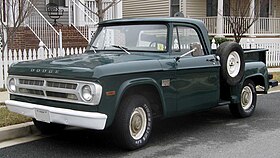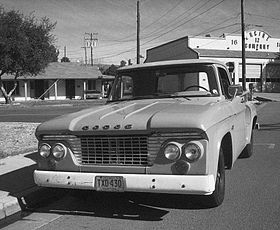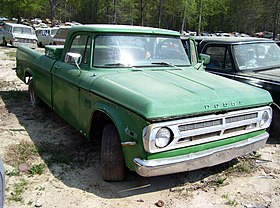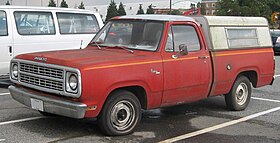Dodge W Series
| Dodge D Series | |
|---|---|
 |
|
| Overview | |
| Manufacturer | Dodge (Chrysler) |
| Production | 1961–1980 |
| Assembly |
Warren Truck Assembly, Warren, Michigan, United States Buenos Aires, Argentina Pretoria, South Africa |
| Body and chassis | |
| Class | Full-size pickup truck |
| Body style | 2-door truck 4-door truck |
| Layout | Front engine, rear-wheel drive |
| Platform | Chrysler AD platform |
| Chronology | |
| Predecessor | Dodge C Series |
| Successor | Dodge Ram (newer platforms have "D" prefixed in its identity) |
| First generation | |
|---|---|
 |
|
| Overview | |
| Production | 1961–1964 |
| Powertrain | |
| Engine | 290 cu in B B 320 cu in B 347 cu in B V8, 361 cu in B V8 |
| Transmission | 3-speed push button automatic |
| Dimensions | |
| Wheelbase | 114 in (2,896 mm) (short bed) 122 in (3,099 mm) (long 8 ft (2,438 mm) bed) |
| Second generation | |
|---|---|
 |
|
| Overview | |
| Production | 1965–1971 |
| Powertrain | |
| Engine | 368 cu in B B 383 cu in B B 421 cu in RB V8 461 cu in RB V8 440 cu in B V8, 361 cu in B V8, |
| Transmission | |
| Third generation | |
|---|---|
 |
|
| Overview | |
| Production | 1972–1980 |
| Powertrain | |
| Engine | |
| Transmission | 3-speed column shifted Automatic transmission |
The D Series is a line of pickup trucks that was sold by Dodge from 1961 to 1980. In the late 1980s, the trucks were renamed Dodge Ram and the same basic design was retained until the 1994 introduction of a completely redesigned Ram. The D Series shared its AD platform with the Dodge Ramcharger/Plymouth Trailduster twins.
The body offered the then-traditional step-style bed, with distinct fenders as an option.
The D Series used the familiar Chrysler B engine in displacements of 290 cu in, 320 cu in, and 347 cu in as the base models, depending on the year. All of Chrysler's larger engines, with the notable exception of the Chrysler Hemi engine were available as factory options.
Another innovation was the introduction of an alternator rather than a generator for electrical power. A three-speed automatic transmission was a major advance—the truck used a two-speed automatic less than a decade earlier.
Yet another innovation, a "Crew Cab" (four-door) body style was introduced in 1963, a first for a factory pickup. Prior crew cabs were custom conversion jobs. A "Club Cab" was also available for 1973, providing transverse seating for either a single third passenger or two small third and fourth passengers (most often, the Club Cab was used as extra cargo space).
The first generation of the D-series was manufactured in Warren, Michigan. They were given the Dodge and Fargo brands, as Dodge D-100 and Fargo De Soto. The trucks were produced by the Dodge Division of the Chrysler Corporation.
1964 saw the introduction of the sporty Custom Sports Special. The Custom Sports Special included bucket seats, console, carpeting and racing stripes. The optional High Performance Package could be ordered with a CSS truck or by itself on a base model truck complete with Chrysler's big 426 cu in wedge-head V8. This engine produced 365 hp (272 kW) and 470 lb·ft (637 N·m)—in-line with the muscle car revolution that was then sweeping Detroit. The High Performance Package also included the LoadFlite automatic transmission, a 6000 rpm-rated Sun tachometer with heavy-duty gauges, power steering, dual exhaust and rear axle torque rods (traction bars) sourced from 1961 Imperials. Custom Sports Special trucks were produced from 1964 to 1967. The High Performance Package was only offered from 1964 to early 1966.
...
Wikipedia
